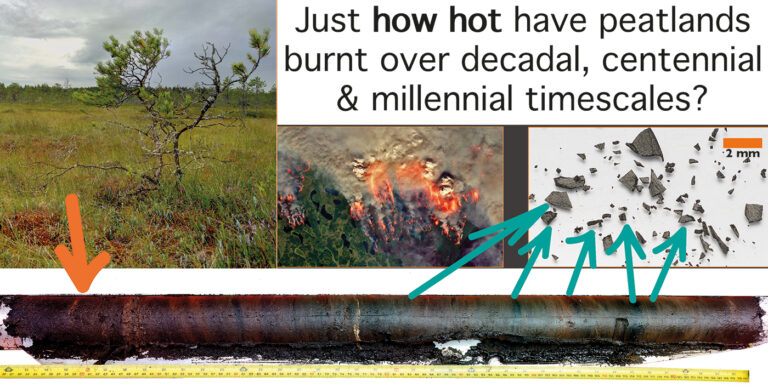Project Description
The aims of this studentship are to i) investigate the possibility of a quantitative relationship between imposed heat fluxes and the Raman spectra of charcoal fragments produced as a result of this heating, based upon a series of cone calorimetry laboratory burning experiments of peat mesocosms, ii) reconstruct burning intensity changes through time using a series of peat profiles recovered from raised and blanket peatlands in the UK.
Future climate change is predicted to strongly increase fire occurrence in peatland ecosystems, which is alarming as Northern peatlands are globally significant ecosystems in terms of carbon storage.
The experimental part of this studentship will involve a series of burning experiments of modern plant taxa collected from peatlands in the UK, where you will simulate ‘real’ wildfire conditions by using a cone calorimeter housed at the University of Edinburgh (Hadden et al., 2013). This instrument comprises a cone heater which exposes the material to be combusted to controlled levels of irradiance, which is then ignited by sparks and consequently burned. The combustion gases produced pass through the heating cone and are collected by an exhaust duct system. In the exhaust duct, the gas flow is measured (O2, CO, and CO2) to calculate the quantity of heat release per unit time per unit area. The Raman band width ratios of the charcoal produced from the cone calorimetry burning experiments will then be measured. Raman spectroscopy, which to date has only been undertaken once on preserved charcoal fragments contained in peat archive records (Mauquoy et al., 2020), involves exposing charcoal fragments to particles which transmit light (photons) emitted from a laser. The final part of the experimental burning work will be to explore the relationship between imposed heat flux and the Raman band-width ratios.
You will collect a series of peat profiles from raised and blanket peat bogs across the UK. The Raman spectra of charcoal fragments preserved in these peat profiles will then be investigated to determine the former range of fire intensities through time (the last ~6000 years, using both 14C and 210Pb chronologies) based upon the results of the burning calibration experiments of the modern taxa. You will also explore the effects of fires on peatland carbon sequestration by measuring the bulk density, carbon content and macrofossil composition of the peat profiles.
The student will be mostly based in Aberdeen and will have regular contact with Dr. Mauquoy. Prof. Muirhead and Dr. Blaauw will provide training in Raman spectrometry and 14C dating respectively. The student will spend some time at Edinburgh University’s state-of-the-art BRE Centre for Fire Safety Engineering and Dr. Rory Hadden will introduce the student to the experimental cone calorimeter burning experiments.
CANDIDATE BACKGROUND
The student will be required to undertake fieldwork sampling peatlands in the UK, perform laboratory analyses (microscopy [light and SEM], select samples for 14C dating, plant macrofossil and macro-charcoal analyses). Experience with palaeoecological fieldwork and laboratory techniques would be an advantage, but training in plant macrofossil, cone calorimetry and Raman spectroscopy will be provided. Efficient time-management will be important given the range of planned analyses.
Image credit: Dmitri Mauquoy, UOA
Supervisors
Dmitri MauquoyPrimary Supervisor: | Profile: Dmitri Mauquoy Email: d.mauquoy@abdn.ac.uk Institution: University of Aberdeen Department/School: School of Geosciences |
Maarten BlaauwSecondary Supervisor: | Profile: Maarten Blaauw Email: maarten.blaauw@qub.ac.uk Institution: Queen's University, Belfast Department/School: School of Natural and Built Environment |
David MuirheadAdditional Supervisor: | Profile: David Muirhead Email: dmuirhead@abdn.ac.uk Institution: University of Aberdeen Department/School: School of Geosciences |
Additional Supervisor: | Dr. Rory Hadden, University of Edinburgh, School of Engineering Email: R.Hadden@ed.ac.uk
Thomas Theurer, University of Aberdeen, School of Geosciences
Email: thomas.theurer2@abdn.ac.uk |
References
Hadden, R.M., Rein, G., Belcher, C.M. 2013. Study of the competing chemical reactions in the initiation and spread of smouldering combustion in peat. Proceedings of the Combustion Institute 34, 2547-2553.
Mauquoy, D., Payne, R. J., Babeshko, K. V., Bartlett, R., Boomer, I., Bowey, H., Evans, C. D., Ring-Hrubesh, F., Muirhead, D., O’Callaghan, M., Piotrowska, N., Rush, G., Sloan, T., Smeaton, C., Tsyganov, A. N., Mazei, Y. A. 2020. Falkland Island peatland development processes and the pervasive presence of fire. Quaternary Science Reviews 240, 106391.
Rein, G., Huang, X. 2021. Smouldering wildfires in peatlands, forests and the arctic: Challenges and perspectives. Environmental Science & Health 24, 100296.
QUADRAT Themes
- earth-systems
- environmental-management






















































